Table of Contents
These are the case interview secrets you need to think like a consultant to solve any case type, conventional or unconventional
Stop. Stop what you’re doing with your consulting case interview prep and listen. I’m not here to tell you that everything you have been doing is wrong. But, it’s also not right.
Are you after the perfect framework for a growth case and a profitability case? You’re thinking about it wrong. Are you reading case after case because you want to cover “all” case types? You’ll never finish. Are you memorizing frameworks, trying to learn every industry out there, aiming for 50+ completed cases? This is not about quantity over quality.
Listen here very closely: You need to think like a consultant in order to pass the interviews designed for consultants.
Listen here very closely: You cannot boil the ocean. You cannot learn everything. And, consultants don’t try to. Rather, work smart and optimally, like a consultant would.
I’m not here to scare you. I’m here to enlighten you. I’m here to share with you the case interview secrets you need to ace your consulting interview.
Here begins the start of your successful case preparation journey. Don’t throw out everything you have learned to date; take what you’ve learned and let me help you upgrade it to the next level.
In this article I am going to take you through how to truly think like a consultant by establishing a fundamental mindset shift in how you approach cases. This will help you solve any case type, with any company, in any region, with any interviewer. I’m not kidding.
Let’s begin.
What is the consulting case interview format?
A strategy consulting case interview consists of a case study and a fit interview….yada yada yada.
Stop memorizing the “what”!
The more you focus on the exact steps of the interview, the exact things to expect, the more you are preparing yourself for failure.
Could you imagine being on a soccer/football team and your coach is preparing you by saying “ok, so in the first 15 minutes of the match the other team is going to x, and then in the 2nd half I know that they are going to y”. Of course not, that would be, well, ridiculous!
Learn the intricacies of the game. Learn the various formations and counter-formations, learn how to react to any situation. If you learn the fundamentals of soccer strategy (angles of attack, positioning, mis-direction, etc.) you can handle anything the opposing team throws at you, correct?
Equally, if you learn the fundamentals of strategic thinking and how consultants work¸ you can solve any case that comes your way.
Wouldn’t that approach be better than memorizing 100 possible attack sequences by the opponent? Wouldn’t that approach be better than memorizing all the possible prompts and frameworks that exist?
Final metaphor using soccer (I promise!): Just like a soccer/football team doesn’t just scrimmage and play matches to get better, you should not just case and read cases to get better. Just like they do dribbling, passing, shooting, and stamina drills, you should be doing math, daily reading, charts/exhibits, and industry deep-dive “drills”. Just like they review tape of past matches, you should review your old cases and, yes, even record yourself casing to look back on it later.
To win their match, teams rely on well-kept training secrets. To ace your consulting case interview, look no further than our case interview secrets.
Ok, but really, what can I expect in my consulting case interview?
Nothing. Expect nothing. Well and truly. Be prepared for the consulting case interview. Be prepared for the fit interview. Know how to market size. But, other than that, don’t expect specific case types, a specific interview format, etc.
Of course, it’s important to know how the interview works. Soccer 101 certainly starts with knowing that the match is 90 minutes, with 11 players, and that only the goalie can use their hands.
But knowing the rules and steps does not make you a good soccer player. It honestly couldn’t even be called step one. It’s what’s called table stakes in strategy consulting – it’s a fundamental baseline required just to be able to be there.
Feel free to read articles on what the Kearney Dubai consulting case interview for a Senior IT Consultant is. Or, google what questions to expect in the Amsterdam Bain office. Whatever you read will have a significantly higher chance of being wrong than right. Why? Because every interviewer is different. Every interview experience is different. Offices change their approach.
Ultimately, everything they do is to test your consultant abilities. The interview and questions are simply a mechanism to test your consultant abilities. Focus on the why and how of casing and consulting, not on the what.
Just as an example, have you heard of the McKinsey PEI? Read up on all the rules and the exact breakdown of exactly which questions are asked and the exact answers they want from you? Well, if you did that, you would probably be devastatingly thrown off by what happened to this candidate:


Now, I’m only trying to wake you up, not be mean. So if you truly want to learn the basics and fundamentals, please first read this article on the most common pitfalls in case preparation and this article on the mindset needed to succeed in your consulting case interviews. If you have the fundamentals down, keep reading for our case interview secrets.
Case Interview Secrets - Part 1: A Case is a Project – A Framework is a Project Plan
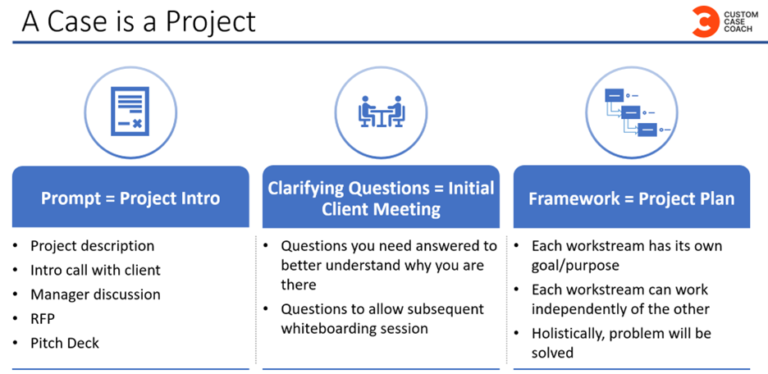

Ok so what’s the first thing you need to know from our case interview secrets? The first thing you need to know when it comes to casing is…it’s just a project! Remember, cases are created by someone. Who? Consultants! How are they created? The consultant literally takes a past project of theirs and turns it into a miniaturized version…i.e. a case.
Ok, so why does this matter?
Well, once you realize that a case is a project, and once you realize this thing actually happened in real life, and once you realize this is all just a roleplay of you as a consultant…then the whole consulting case interview is now contextualized for you! Of all the case interview secrets, this is the most important one to internalize early in your prep.
You know how a case starts off with a prompt? That’s just the project intro that your boss might give you on day one.
You know how you’re supposed to ask clarifying questions? Well, maybe instead of generically and mundanely asking “Where is our client located?” or “What is the timing” or “Do we have any specific goals or objectives?” you ask questions that actually matter.
As the interviewer, I don’t care that you can regurgitate things you have read online. I care that you are genuinely asking questions that you would ask in a real life engagement on day one. I want you asking questions that are going to affect your approach to solving the problem.
If your clarifying questions actually help you better understand the problem and situation, if they help clarify something you didn’t understand, or they narrow and define your scope better, then they’re good questions! If they’re repeated mindlessly with a blank stare…well, they’re not!
You know how you’re supposed to drive the case forward (in a candidate-led case)? Well, in real life would you ask random questions to the client like “do you have price data?” or “do you have a list of our customers” or “have any competitors entered the market?” or “can we raise prices?” or “what are our margins?” Of course not!
Rather, in real life, you recognize that you can only send one email at a time and have to wait days for a reply from a client. You realize you have 1 workshop at a time. You realize you can only pop over to the client’s desk so many times. And so, you ask objective-driven high-level umbrella questions like “I’d love to take a deeper look at the market to understand if it’s even attractive. Do you have any information here that could help me?” or “If we don’t have a breakdown of our existing stores and what we can do to improve them, another option to grow revenues might be to launch more stores. Have we considered this option and if, so do you have any data for where we might be able to launch?”
This applies throughout the entire case.
Here’s a one sentence summary of an optimal candidate:


When in doubt, think “what would a consultant do”.
This applies to chart and exhibit reading, math, brainstorming, interacting with the interviewer, final recommendations, and, you guessed it, frameworking.
How Do I Actually Framework – Truly Creating an Objective-Driven Solution
Ok, so, if you can’t memorize frameworks, then what can you do? Well, rest assured, this approach will actually take you less time than memorizing. And, this is all while it will increase your chances of passing the interview and make you a better consultant.
Remember, casing starts with frameworking. You need to get frameworking down because it is the foundation of everything else you do. Not only is it critical to framework well for your case assessment, but it also impacts how the rest of your case goes. Additionally, the techniques of frameworking are embedded in case leadership, exhibit reading, communication, market sizing, and even your fit interviews.
Yes, being able to framework properly also allows you to do well in the rest of your entire interview. Why? Because frameworking properly is about learning how to answer any problem that comes your way in a structured and organized manner. If you can do that, you can do anything.
To start, take a look at the below framework for the question “should we enter the market?”. Without moving forward, reflect and say out loud whether you think it is a good framework or not, and why.
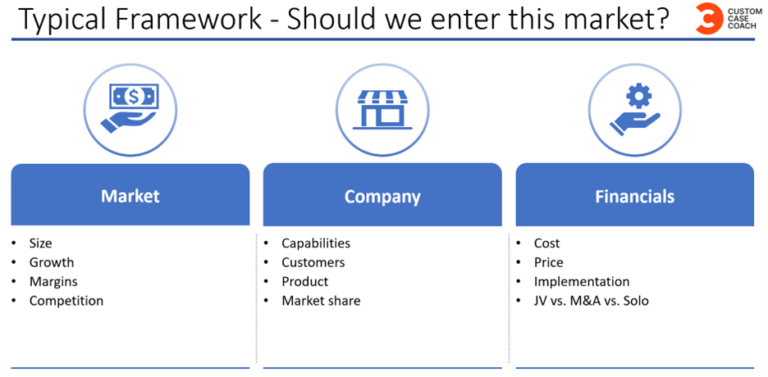

Ok, have you reflected on the framework? Scroll down to see the answer.
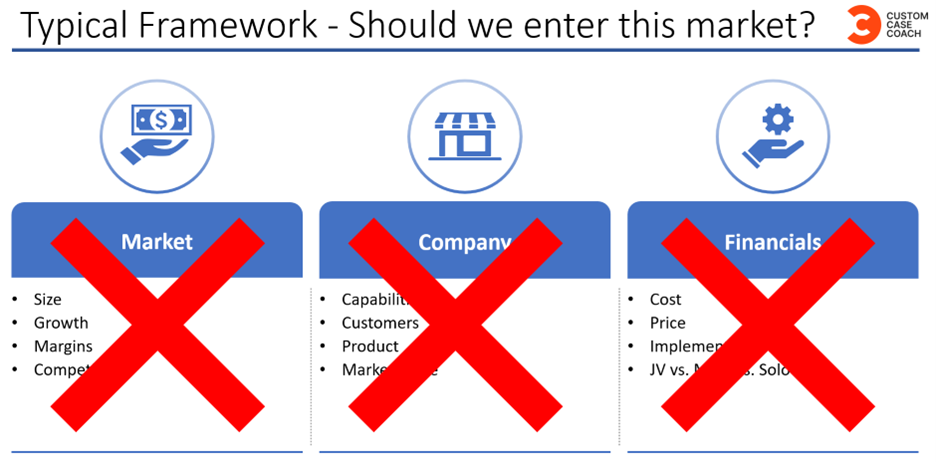

It’s wrong!
But wait, I’ve seen this everywhere, you might say. Isn’t this what everyone does?
Sure, many do this when casing. But consultants and those who ace their consulting case interviews, don’t.
The problem is, you are just saying words.
You’re saying “I want to look at market, company, financials. For market I want to look at the size, growth, and margins”
Ok great, but what does that mean?
The problem here is that you are not being objective-driven. Your framework is not a project plan. I have no idea, how, at the end of all this, you will have come to a solution and an answer for the question at hand.
Rather, this is a good framework:
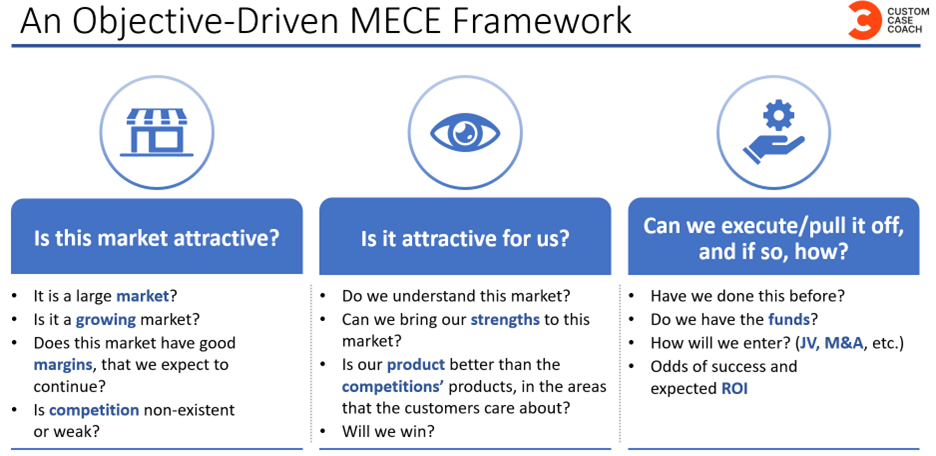

Or, this (same thing, just statements instead of questions):
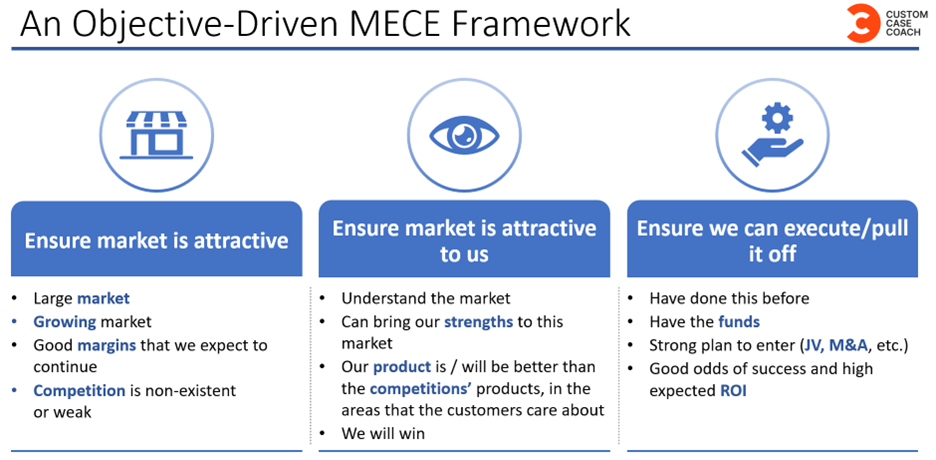

Ok, so, why is this good? Well, it is are making it clear WHY I’m saying what I’m saying.
Instead of saying “I want to look at the market, company, competition”, I’m saying “In order to assess whether or not we should enter this market, we need to first make sure that this is an attractive market in the first place. That this is a space we want to play in. Secondly, we need to figure out whether this is an attractive market for us. As in, will we be able to win in this market. Finally, if this is true, we then need to make sure that we can actually execute and pull this off.”
Now, you tell me. Which framework actually sounds like a consultant who’s paid millions of dollars to solve a client’s problem? The one shown earlier, or these two?
If you want to hear what good sounds like, listen to the following video lesson from my course where I talk through this. If you want to hear what good sounds like and gain a more in depth understanding of frameworking, you can check out the course here, or, watch the free video here:
Or, what if we’ve been brought in to decide between three markets?
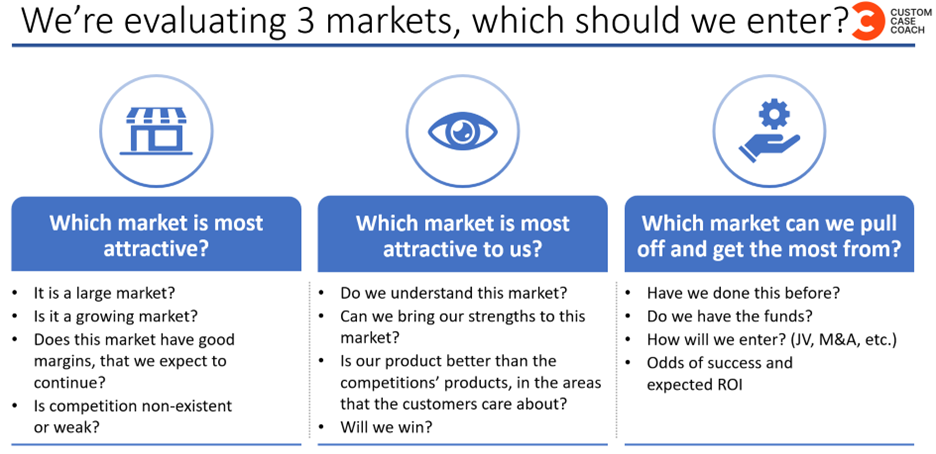

Or, what if we have already decided to enter the market? Another team has done the above analysis, and now we are tasked with determining how to enter the market?
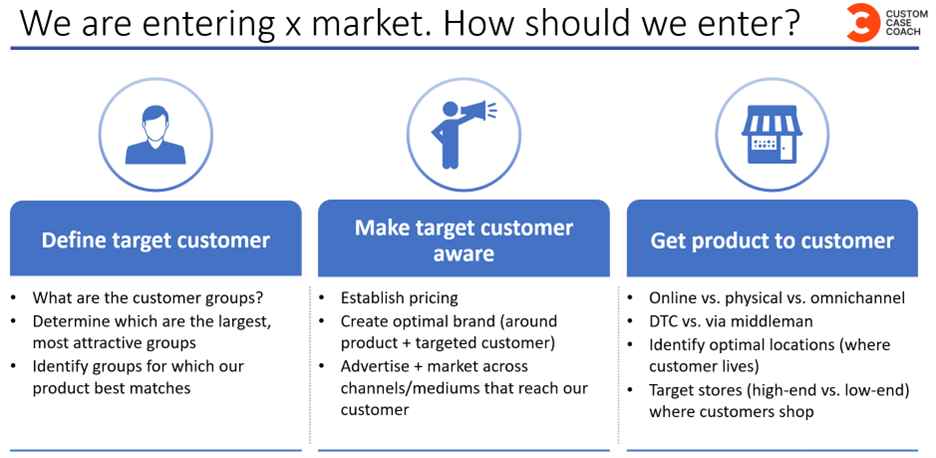

See how I need tailored, objective-driven frameworks in the context of the question itself? You cannot rely on just 1 market entry framework. In fact, even the above ones don’t make you “safe”.
Please, don’t give up. Through the next five case interview secrets I am going to teach you how to approach any and all of these market entry prompts AND any other prompts that come your way in your consulting case interview.
Case Interview Secrets - Part 2: Frameworking Principles to Solve Any Case Type
So, before I jump into the second part of our case interview secrets, please remember that nothing beats coaching and the 360° course for learning this. I highly encourage you to take a look at both if you truly want to master your consulting case interviews. However, I am going to do my best to teach you the fundamentals here.
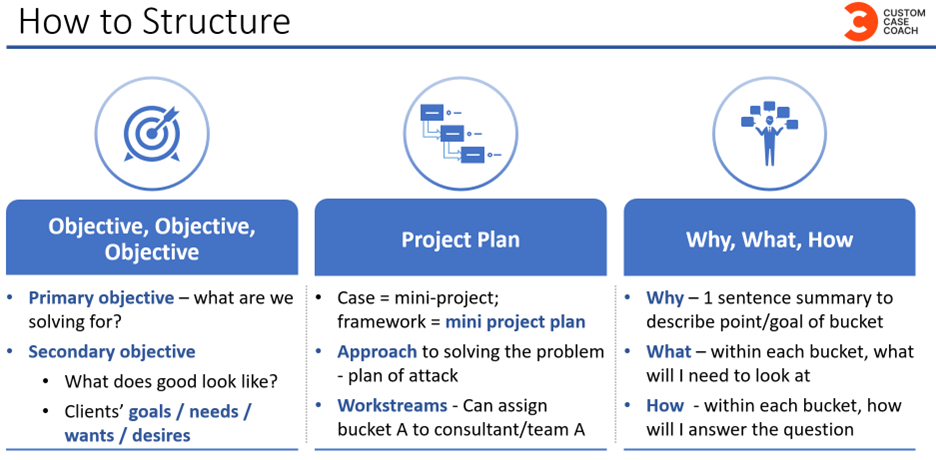

Now, I’m going to talk through how to truly structure. Mastering this sets you apart from all the other candidates. It drastically increases your odds of passing your interviews, and, critically, it’s going to make you a better consultant.
However, please remember that this is a long process and it is difficult to master frameworking. It normally takes weeks of coaching. I’m trying to get you everything here on paper. But, fundamentally, you need to practice this a ton, you need to push yourself, and you need to be self-critical while also being patient with yourself.
Crucially, remember that everything you will read below is just the beginning. I am setting you up, but the structuring mindset shift is a multi-week/month journey.
Ok, so, without further ado, let’s jump into the 2nd part of our case interview secrets series.
Let’s start with the basics/foundation
If you work better learning in video format, here’s a video direct from the course, free for you today.
To optimally structure, remember the following:
Objective, Objective, Objective
So how do you actually structure? Well, there are a couple of key things to keep in mind. Number one objective, objective, objective.
Nothing is more important than the objective. You can have the best answer in the world, but if you’re answering the wrong question, you have the wrong answer. So number one, before you framework, before you brainstorm, before you create any type of structure, make sure you are crystal clear on the objective.


Objective, Objective, Objective
What are you being brought in for? What is the question being asked? What do you have to solve? Now, there are two types of objectives. For the most part in every case, there’s the primary objective, which is the literal question you’re being asked: do we do this, do we not do this, how do we do this? The literal question, the question you are here to answer and solve for, is the primary objective.
But most cases and most case prompts have a secondary objective. And this is essentially what does good look like? What are our clients goals, needs, wants and desires? So, in trying to grow, are we trying to grow revenue? Are we trying to grow profit? Do we have a specific target? In trying to do X thing, what are we really trying to achieve? That is what a secondary objective is. Make sure that you are clear on both the primary objective in a case and the secondary objective – the client’s goals, needs, wants, desires – before you try and dive into the framework itself.
A Framework is a Project Plan
In addition, when you are creating your framework, remember that a case is really just a mini project and therefore a framework is a mini project plan. Everything you are doing in the consulting case interview is miniaturized. It is a condensed version of a real-life project. As such, your framework is ultimately you creating the plan of attack. It is your approach to solving the problem.


A Framework is a Project Plan
So, think of your buckets as workstreams. Think of each section of your framework being something that you would assign to individual A or team A that they would have to go and run off and complete on their own. They should be able to work independently. They have a sort of mini question that has to be answered and what has been broken out is clear in terms of what they need to go do. And then all of these workstreams or teams, once they’re done, can be put together to solve the problem. That’s all that MECE means!
Just remember, when I’m creating our framework, it’s really about creating a project plan. It is NOT solving the problem, it’s your APPROACH to solving the problem. It’s that whiteboarding session that you have before the project to figure out what are you actually going to do and how.
Be Clear on the Why and How
Make sure to articulate the why, what and how as you go through your framework.
Start off by signposting or summarizing each bucket with a sort of why statement. State what you want to look at, what is the goal, the mini objective of each bucket. Do this in a succinct sentence.
After you’re done signposting, you should go into each bucket and as you go through them, you have substructure and you’re articulating the what and the how. What are you going to look at and how is it going to answer the question?
Case Interview Secrets - Part 3: Have a General Understanding Of Most Problem Types
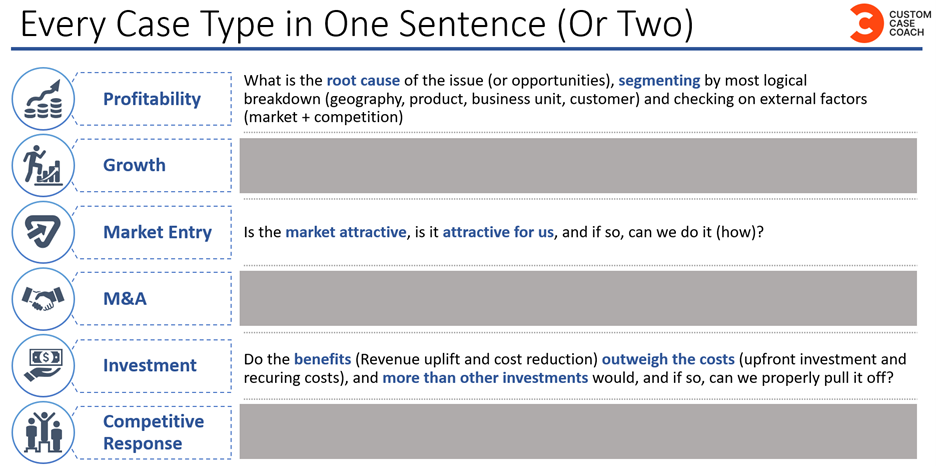

Above you see a one-sentence summary for some of the most common case types. Of course, remember that there are “infinite” case types. And, remember that there are many types of market entry, M&A, etc. However, having a simplified, clear version of the fundamentals in your head is immensely helpful.
While this may not be the most surprising of our case interview secrets, you would be surprised how many people skip over this when preparing for their consulting case interviews. Before you even learn buckets and approaches, make sure to carry with you an overarching understanding of the major case types.
It’s best if you create these yourself, but a few are provided to you above. Of course, in the 360° course all of them are revealed. In the course I also provide you with 8 unconventional (not classic) frameworks that you can use flexibly in your consulting case interviews across numerous case types and across various firms and geographies.
Case Interview Secrets - Part 4: Understand How They All Connect
Now, you have probably already found a few frameworks on the “classic” case types (profitability, growth, market entry, etc.).
It may not surprise you at this point that I’m going to tell you that’s not enough! You cannot view each case type in isolation.
In business and in strategic thinking, all of these topics are connected. Likewise, in casing these topics are connected. A profitability could lead to a growth case, could lead to a market entry case. A case may be an M&A, but the prompt tells us the Market Entry “team”has already come in and worked to determine an M&A was needed. A Market Entry case might have pricing or competitive response embedded.
Do not just memorize one framework for each case type and do not view them in isolation. Rather, learn how they actually work and how they connect to each other.
To help you do this, I have created a 1 page visualization of every major case type and how they connect to each other. I call this the World of Frameworks.
This is an impossible topic to write down (it has to actually be talked through verbally). As such, I highly encourage you to register and check out the free course video of the World of Frameworks.
While part 4 of our case interview secrets is a general statement, the true value comes from the myriad “mini” case interview secrets essentially embedded in the World of Frameworks.
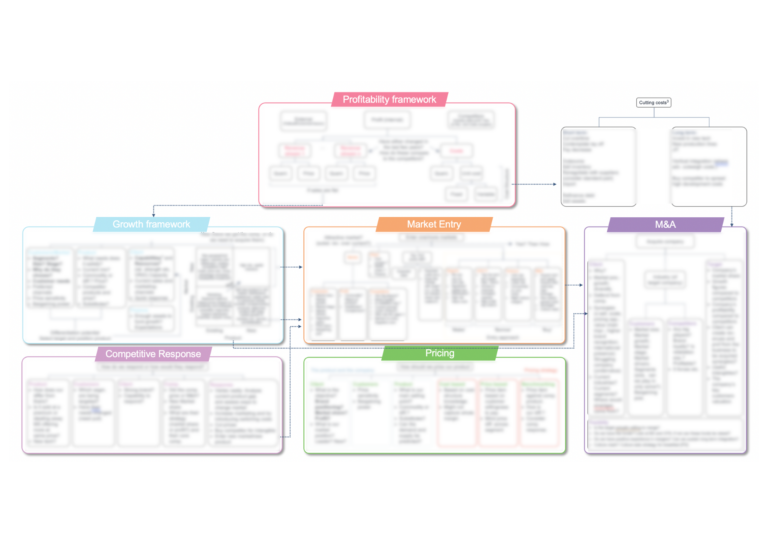

The World of Frameworks
Case Interview Secrets - Part 5: Take Out The Noise With Non-business Prompts
Ok, now I get to jump into my favorite of all the case interview secrets. No one else is doing this, and it provides a fundamental mindset shift in how you can approach frameworking. One of the main things I focus on in my course and coaching is non-business prompts.
It’s so easy to get distracted and overwhelmed by all of the advice, frameworks, terminology, etc. out there. Instead of trying to learn how to be MECE while also trying to learn all of this, just cut out the noise! Start with the basics. Work on what I call non-business prompts.
Let’s try one here.
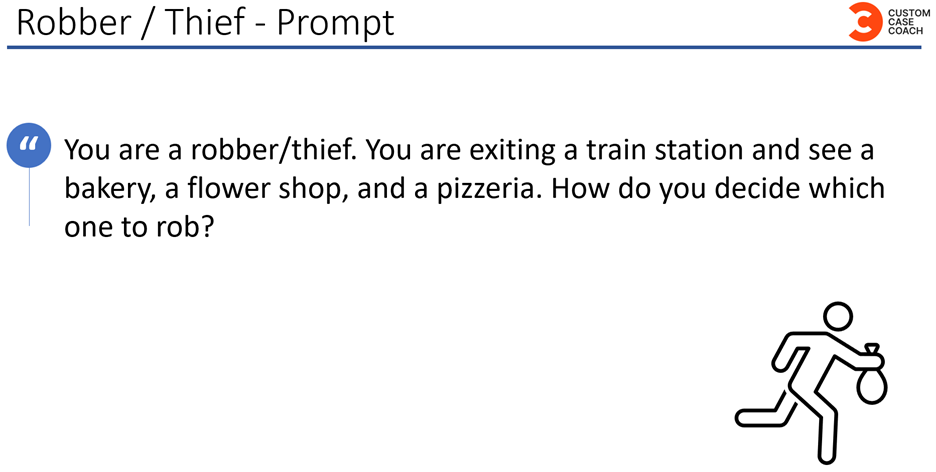

Think about what your clarifying questions are, and then also think through the framework that you would create for this prompt. Once you have, take a look below .
Were any of the following your clarifying questions?
- What time of day is it?
- Am I robbing alone or with someone?
- Where are these shops located?
- Am I taking the train back?
- Are there police nearby?
If so, you asked the wrong questions! None of these questions change the APPROACH you would have to solving the problem.
Rather, there are 2 questions and 2 questions only that matter here:
- Am I robbing cash or can I rob anything?
- What are my goals with robbing? (Get rich, feed my family, for fun, etc.)
These two questions are the only questions whose answers fundamentally change my framework buckets. You’ll see why in a moment.
For your framework, let’s assume you can rob anything and that your goals are to get rich.
Framework 1:
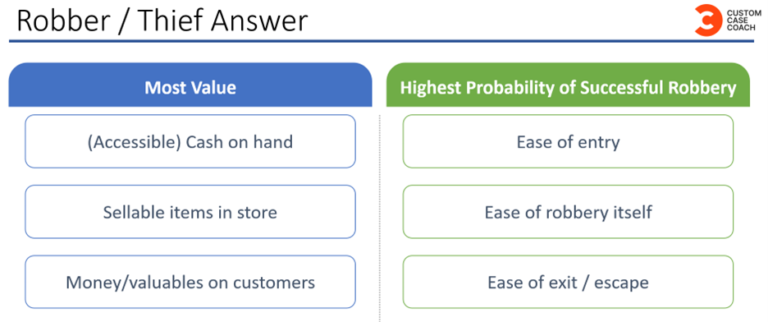

To select one of the 3 stores, fundamentally there are only 2 things that matter: I want to get as much value as possible and I want to escape. I will rob the store that gives me the most money/value and that has the highest chance of me getting away.
Nothing else matters.
See how MECE this is? Nothing you can think of does not fit into one of these buckets. That’s collectively exhaustive. And, nothing you can think of fits in both of these buckets. That’s mutually exclusive.
If you create two workstreams of work, or two teams, or two excel tabs, that go in line with these 2 buckets, you have covered all of your bases.
Now, look at how MECE the sub-buckets are! You absolutely need to aim for this in your frameworking (specially for McKinsey case interviews).
For Most Value, there is the cash in the store itself, there are the items in the store that we can grab, and finally there are the customers themselves that we can rob. Perfectly MECE. Now, remember, there are multiple options here! Our sub buckets could simply be the value of the store and value of customers. Or, they could be the value of cash and value of items. It doesn’t matter which subbuckets you have! As long as they are objective-driven and MECE.
Looking at our second bucket, again, you can see how MECE the sub-buckets are. There’s the ease/risk of entering the store, the ease/risk of robbing the store, and the ease/risk of exiting and escaping. There are not other moments in which there is risk. Breaking these moments out and measuring the risk across all of the stores will allow us to have an overall view of our odds of success.
Now, there are other sub bucketing options here, which I share below.
Framework 2:
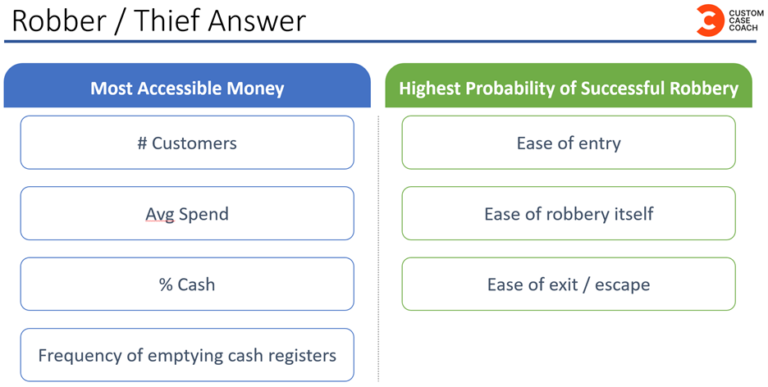

Ok, so, what’s different here?
Well, for one, I have said “Odds of getting caught” for our second bucket. This isn’t any different! It’s just to show you that you can use different wording and still get the same point across.
What is different however is our 1st bucket. This bucket would exist if we shed light in our clarifying question that our robber can ONLY rob cash. See how that clarifying question directly impacts the framework and is therefore a good question? Now, we can’t look at value, we have to look at cash.
As such, across all 3 stores, we would look to estimate the # of customers that come through the store, the amount that they typically spend, the % that spend in cash, and the frequency at which the store empties the registers. This would allow us to get a view as to which store will have the most cash on hand.
Framework 3:
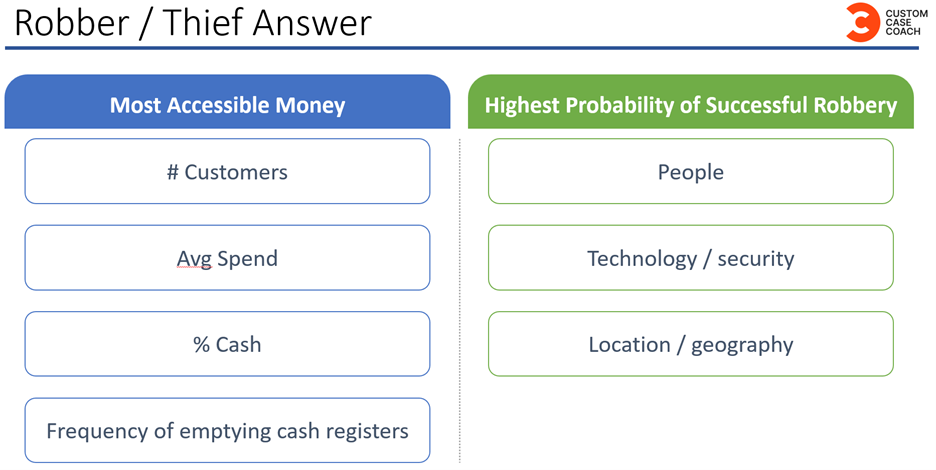

Now, the main point of showing you this 3rd framework is to demonstrate an alternate set of sub buckets for our second bucket. These subbuckets can apply to framework 1 and 2.
Here, I’m saying that, across all 3 stores, we want to assess:
- The people’s willingness and ability to resist us
- The level of technology and security and our skills/tools to mitigate this
- The location/geographic layout and how much that will aid/hurt our execution and escape.
If you want a killer set of sub buckets you can actually combine entry, execution, and escape from frameworks 1 and 2, and say you will assess those 3 phases across people, technology/security, and location/geography.
Woah! Job offer here I come!
Summary
Do you see how important it is to be objective-driven? I.e. to answer the question.
Do you see how important it is to have an approach to solving the problem, not solve the problem yet?
Do you see how random clarifying questions like time of day, who I’m with, etc. do not actually change my framework and therefore should not be asked?
Do you see how important it is to be MECE?
Do you see how important it is to have MECE sub buckets?
Finally, do you see how important it is to not just write down random words, but actually have substance behind them, i.e. the why and the how?
Of course, this prompt will not appear in any real consulting case interview. However, once you learn to do this properly, you can build off of it and add in the business context.
Now, if this is hard and you did not get these frameworks perfect, that’s ok. Most people don’t! And, from my experience coaching thousands of candidates, even those who think they did have a good answer, actually didn’t.
You have to practice to get better. I recommend you come up with a random non-business prompt each day and work to create a framework. Importantly, record yourself giving the framework, and watch yourself. It’s painful to do but you will improve!
Here are some prompts to consider:
- You are at work and did not bring your lunch. How do you think about where to go for lunch?
- You have multiple job offers. How do you select one?
- You are walking down the street and a dinosaur comes around the corner. How do you react?
- You are headed on vacation. How do you choose a destination? (Needs to apply to anyone, anytime, anywhere in the world)
- How would you furnish an apartment/home?
- How do you decide whether you should buy a house/apartment?
- How would you determine how to take back an enemy’s base?
- You are preparing for case interviews, how do you optimize your preparation?
- How do you decide whether or not you should get a case coach?
If you’d like to see the optimal frameworks for these prompts, and/or want input on if you are doing it right remember that there is so much more in the 360° course. And, remember that nothing beats the direct feedback and training that comes from 1-on-1 teaching….almost everyone does this wrong until their first coaching session (read: wakeup call). Please don’t just assume you’re good to go on your consulting case interview: invest in yourself to ensure you’re ready!
Case Interview Secrets - Part 6: Use the Structure Up and Structure Down Approach
Ok, so how do we actually apply and do part 5 of our case interview secrets?
Well, there are two major approaches that you can take when trying to create a framework. Of course, we already know we need to be clear on our objective, that we need to create work streams, et cetera, et cetera. However, you can leverage the Structure Down and/or the Top Down approach when actually figuring out these workstreams.
The Structure Down Approach
The first approach to figuring out your framework buckets is the structured down approach. What does this look like? Well, with the structured down approach, once you are clear on the objective, you need to think: “what buckets do I already know about? Okay, I know about cost and internal and price and competition and company. I know about x, y, and z”. As you do this, you need to let the ones that appear and pop into your head and seem to apply to come into play? So when you hear the prompt, when you hear the objective, what pops into your head as the most likely candidates as buckets? Which ones just seem to fit right?
You might go, okay, I’ve got all these different buckets I could use, but financials, market, and company seem to be the things that I want to use. Company, I have a whole bunch of questions. Market, I have a whole bunch of questions, et cetera. Then once you have your buckets and you’re clear on overall what you’re trying to do, populate those buckets? So you can fill in the market bucket, you can fill in the company bucket, and you can fill in sort of the financial bucket..
To summarize, for the structure down approach:
- Be clear on the objective
- Think of all the buckets out there
- Think about which buckets likely apply
- Populate those buckets
As already mentioned, the 360° course provides you with dozens of buckets that you can use in your structure down approach.
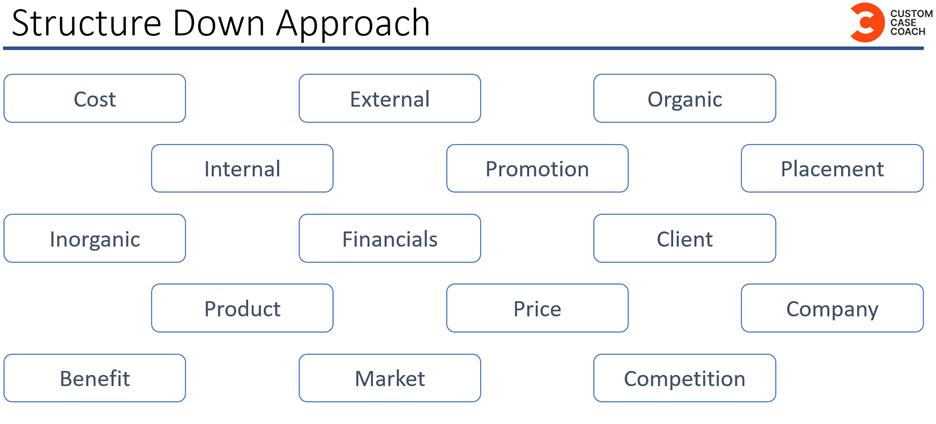



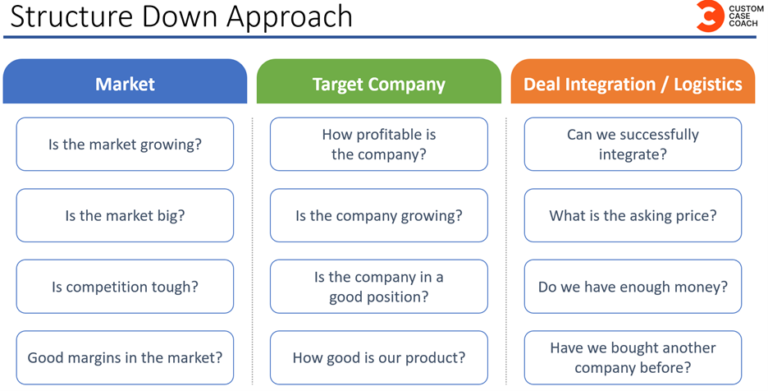

The Build Up Approach
The second approach is the build up approach. As the name might indicate, in this approach you’re moving from the opposite direction. As in, you are identifying all the things you want to look at and ask, and you are building up to buckets from that set of ideas.
For example, you might ask:
- How profitable is this company?
- Are they even in a good position?
- What’s the asking price?
- Do they have a good product?
- What is their market share?
- What is their profitability?
As you let those questions appear, you can start to realize the theme. In this case, it is quite clearly company.
You might wonder if the market is growing, if the market is sizeable, if there is strong competition in the market, what the margins of the market are, etc. Ah! I just keep hearing market. It sounds like I need a market assessment bucket.
Let’s do a quick exercise. Let’s start with 9 words that you need to group into 3 buckets. I’m going to give you 9 words. I want you to group them into 3 buckets. Here they are:
- Cow
- Sheep
- Apple
- Chair
- Banana
- Goat
- Couch
- Bed
- Strawberry
What were your buckets? Why, animals, fruit, and furniture of course! This is the build-up approach to frameworking.
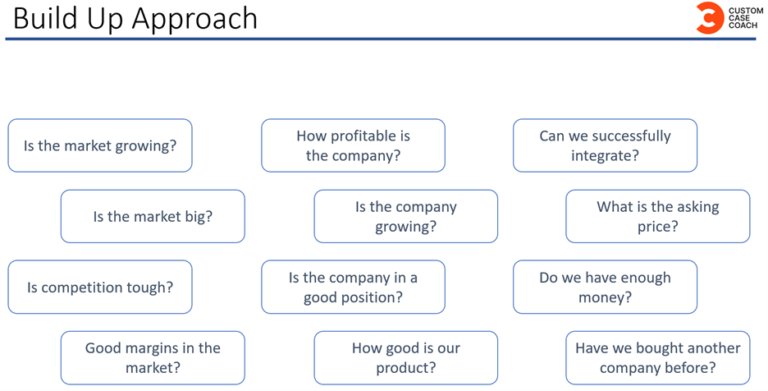

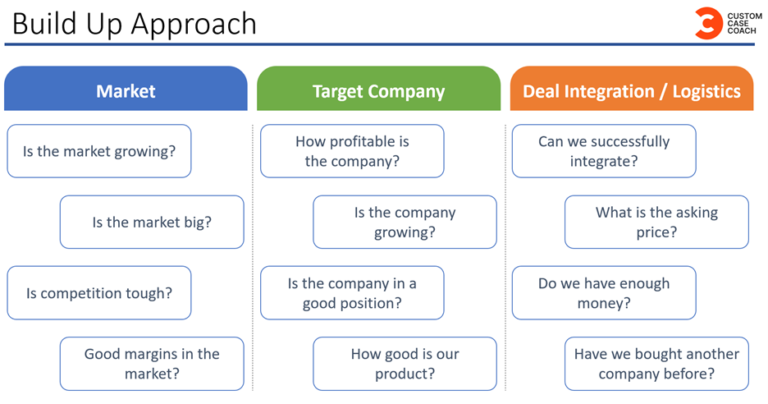

But Which Approach Do I Use?
Ok, but when I’m actually in my consulting case interview and I get a case prompt, how do I know which approach to use?
Here are some key things to keep in mind:
- Either of these two approaches work – neither approach is inherently better or worse than the other
- Take the approach that works best for you, for that case
- A different approach may be easier for a certain prompt than another – it depends
- You can use both in conjunction, for the same framework if helpful
It’s important to note that some people are just natural builder uppers, some people are natural structure downers, some people are a combination and some cases lend themselves really nicely to one or the other. Ultimately, this is a tool to help you framework for any case prompt. As such, use it as something to help you framework without worrying too much about which is the best to use!
Both approaches are equally reasonable and context specific in terms of you and in terms of the case itself. If you’re looking to practice these two approaches, remember that I have dozens of prompt + framework exercises for you. Also remember that, if you’re struggling to master this, coaching can help you hone your frameworking skills.
Let’s Solve an Unconventional Case
Ok, so let’s try to put the above case interview secrets and learnings to the test. Try to be patient with yourself here; it’s unlikely you will get this right, but the point is to try. Again, this process takes many weeks, even months to fully learn. (Make sure to dedicate the necessary time and energy into getting sufficiently ready for your consulting case interview).
Have a read of the prompt below and try to come up with an objective-driven, MECE framework.
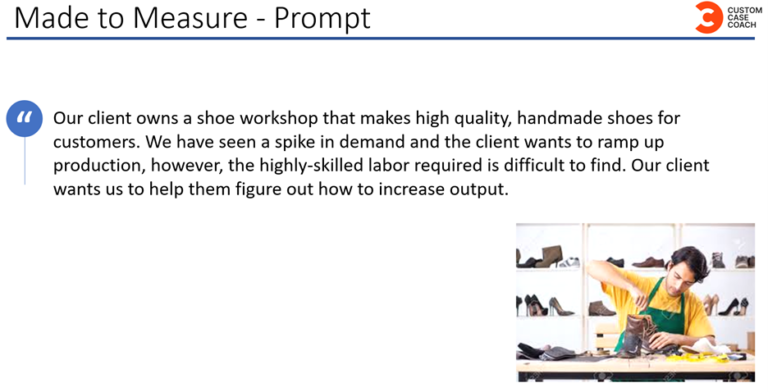

Ready? Ok, if you’ve given it your best shot, then read the frameworks we have for you below.
Framework 1:
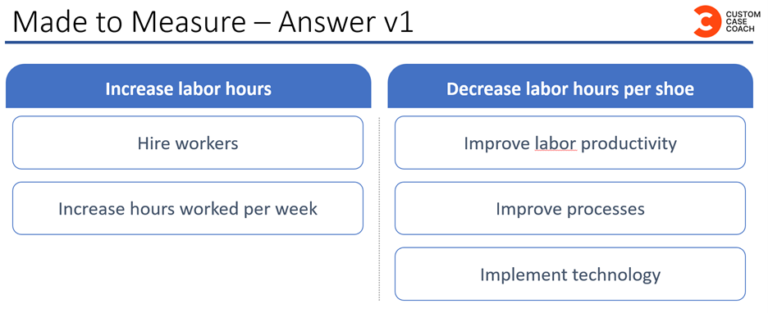

So, fundamentally, we can either increase the labor hours put in or we can improve the efficiency of production (labor hours per shoe). If you note, the prompt never said finding labor was impossible, just difficult (this would make a great clarifying question, by the way).
As such, this is a perfectly MECE framework. Keep in mind, we can use different names for these buckets. For example, bucket 2 could simply be called productivity or efficiency if we want.
Additionally, look at the sub-buckets here. We can either hire more workers or have each worker work more hours. Those are the only 2 ways to increase labor hours!
Within the 2nd bucket, we can either make our labor inherently more productive (training, incentives, etc.), and/or we can optimize our processes, and/or we can bring in technology (keeping in mind quality). Again, these are completely separate concepts/themes and they are holistic.
Framework 2:
Now, take a look at what we’ve done with framework 2. Essentially, we moved hours from the 1st bucket over to the second. Now, instead of labor hours we have laborers, and instead of productivity/efficiency in the context of hours we have productivity/efficiency in the context of workers.
This is an equally strong framework. It is still perfectly MECE.
Note: If we wanted, we could take “increase hours worked per week” in our 2nd bucket and merge it with labor productivity. We just kept it separate here to articulate the point of moving hours worked per worker per week.
Now, look back to bucket 1 and see, again, how MECE those subbuckets are. We can hire workers by finding those skilled ones that exist in the market but haven’t been found yet. Or, we can grab the skilled ones who have already been found (grab from competitors). Or, finally, we can train unskilled workers to be able to handle our leather shoes.
And, look, we even have subbuckets within subbuckets! We can train leather workers to work with shoes, or we can train shoe workers to work with leather.
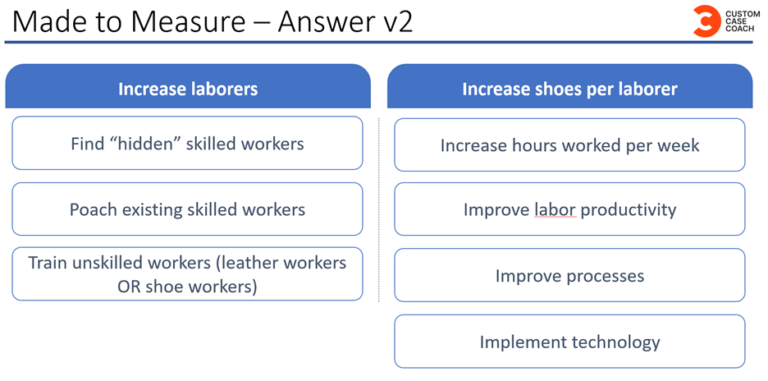

Framework 3:
Now, with framework 3, I just want to show you an alternate subbucketing for the first bucket.
In this case, we can be better at bringing/enticing workers to us (pull), we can be better at physically going to them (push), and, finally, we can make the inherent role more attractive to workers (so that efforts 1 and 2 yield better results).
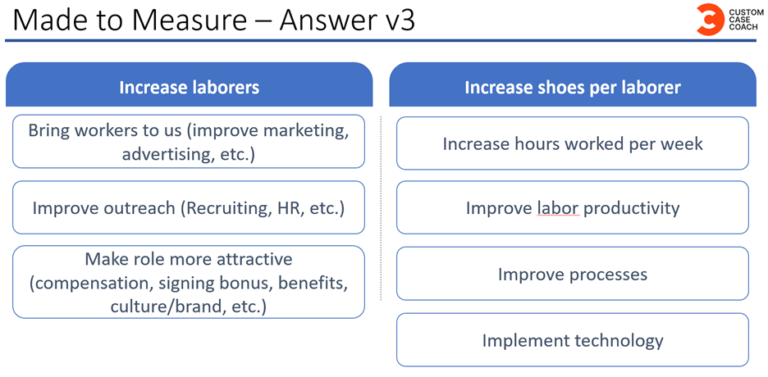

Framework 4:
Now, you may have noticed, but a few words keep appearing in the above frameworks. We keep seeing the word labor. We keep seeing the word technology. And, we keep seeing the word processes.
So, why don’t we group them?
Voila framework #4.
Here, we take all of the labor terms and group them into Labor (make labor better/more). We make processes its own bucket to flesh it out further, and we separate out technology into its own bucket.
As always, check out the MECE-ness of these subbuckets!
For labor, fundamentally, the only way we can get more out of our labor is to hire more people, have them work more hours, train them to be inherently better, and motivate/incentivize them to work harder.
For processes, there are the individual steps themselves that we can make better, there are the handoffs between steps, and then finally there is rejigging/organizing the overall process. Visually, you can see how this is completely exhaustive and each item is separate.
Finally, technology can firstly be used to supplement (replace) workers, thereby freeing them up to work elsewhere and/or improving the flow of that work item. Secondly, technology can be used to complement workers, thereby making that work item more effective and productive.


Framework 5:
Ready to have your mind blown?
Every framework I have just gone over – framework 1, 2, 3, and 4 – can be squeezed into one subbucket.
That’s right, everything we have just done can go into the 1st subbucket of the 1st bucket.
How and why?
Well, if our clarifying questions had revealed to us that our task is to increase output by “a bit” (say, 20%) and quite urgently in the near future (say, under 12 months), then the previous 4 frameworks work quite well.
However, if we have to, say, double our shoe output, and we have multiple years to do so, then, well, we are making a grave mistake to narrow our scope/framework.
We can no longer focus on just our existing factory. Rather, we do need to consider building a new factory, and, of course, looking at external options such as outsourcing and buying up competitors.
See the importance of clarifying questions and being clear on your secondary objective?
With this new scope we now know we have to look internally at what we can do to grow output. This is optimizing our existing workshop and looking at building another. And, we have to look at how we can get help from outside of just our own business and abilities.


Now, spoken words are much easier than text. So, have a look at this explained in a live candidate coaching session.
Please also remember that any of the above 5 frameworks could be used successfully in a consulting case interview.
Conclusion
I hope that my case interview secrets as well as above exercise have helped you understand the critical elements of casing and frameworking:
- Multiple strong frameworks exist for a given prompt
- Always be clear on the objective
- Always be clear on the secondary objective
- Ensure you are holistic in your approach
- Ensure each of your buckets encapsulate their own themes/concepts
- Ensure you have structure even within your subbuckets
Now, your job is to learn how to do this for any case type. Remember, in the 360° course and my coaching I provide you with a ton of practice prompts and multiple framework options for each prompt, just like what you see above. Through the course and coaching, I apply these case interview secrets (and many more) to get you 100% ready for your consulting case interview. These case interview secrets and methodology are the foundations for acing any consulting case interview, anywhere in the world, for any firm and for any role. They are also the foundations of being a consultant.
Additionally, I have a list of the major set of unconventional buckets you can leverage for unconventional cases. And, wow, look at that! Framework 1, 2, and 3 leveraged the Inputs and Efficiency buckets, Framework 4 leveraged (part of) the People, Processes, and Tools buckets, and Framework 5 leveraged the Internal and External buckets.


Please remember this process takes time and effort to get right. The purpose of this case interview secrets article was to give you a foundation. However, it is going to take weeks and even months to properly do this. Many candidates are not able to get there alone and I cannot recommend my course or coaching enough.
This article was just a taste of what is in the course. If you want to learn even more ways of properly frameworking, if you want dozens of practice prompts and frameworks, and if you want to take your frameworking to the next level with guided lessons and exercises, the course is for you.
If you’re worried you “don’t know what you don’t know” and need someone to actually guide you and teach you how to do all of this, coaching is the most powerful tool at your disposal and results in, by far, the highest rate of interview success.
I hope this has given you the beginnings of a mindset shift. I hope that this is the beginning of your transformation into a case king and a top consultant. And, I stand ready to assist if you need any help getting there and if you want to maximize your chances of acing your consulting case interviews.
Good luck!
Recommended For You
Want to learn how to ace your case interview? Found this article useful? We recommend the following to help you level up and get that offer:










